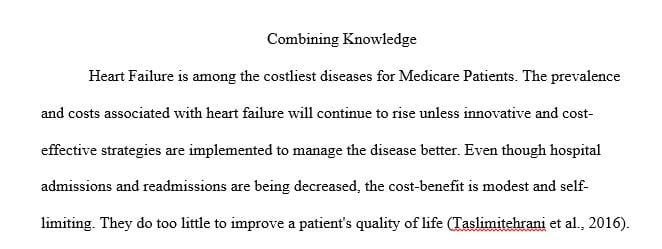Heart failure across the United States continually tops the list on the costliest diseases the population battles
http://www.ncbi.nlm.nih.gov/pmc/articles/PMC3540578/
Joy Stafford
Combining Knowledge
COLLAPSE
Heart failure across the United States continually tops the list on the costliest diseases the population battles, but beyond the cost associated, the prevalence of this disease continues to rise (Sun et al., 2012). According to the CDC, approximately 6.2 million adults across our country battle heart disease. In 2018 alone, it was the cause of death listed on 13.4% of all death certificates written, and is estimated to be associated with over $30 billion in medical costs (Heart Failure, 2020).
Electronic health record systems have been pushed by the United States government over the last ten plus years, hoping to decrease costs and bring more understanding to the instances of chronic health issues in our country while using data to help increase the nation’s overall health. Patient-centered care has been a driver for utilizing the data of EHRs by tailoring care, supporting clinical decisions, and identifying early risk factors such as those connected with heart disease (Nelson & Staggers, 2018).
The research stated in “Combining knowledge and data-driven insights for identifying risk factors using electronic health records” takes a look at the assessment of risk factors presented by those with heart failure diagnosis using the knowledge-driven factors, provided by literature and specific guidelines, as well as data-driven factors which are established based on observation (Sun et al., 2012). Combining the two sets of data into the EHR system to generate a predictive model, helping to alert health care professionals and patients before heart failure diagnosis, can help decrease the number of diagnoses and encourage preventative measures to increase positive health outcomes. This hybrid strategy encompasses a more comprehensive approach to predictive modeling (Sun et al., 2012). With the lifetime risk of an American who will face heart failure being 1 in 5, predictive models can be beneficial not only to the patient but also to physicians in prescribing more aggressive preventative plans to help decrease risk (Taslimitehrani et al., 2016).
In this study, 4,644 heart failure cases, 45,981 control patients, and over 20 million EHR records were included (Sun et al., 2012). The framework was put together to include both clinical knowledge-based data from the typical risk factors like hypertension, diabetes, coronary heart disease, and more, as well as operational data risk factors pulled from the EHR system. The merging of lists provided a way for the EHR system to interpret all sources’ risk factors and allow predictive capabilities (Sun et al., 2012). When tested, the results provided a 20% improvement in risk assessment, which can be seen as lives saved, quality of life improved, or longer lives due to earlier prevention methods being prescribed.
Utilizing EHR systems in the most optimal way to increase prediction models’ accuracy can help patients with risk factors and help future research through clinical trials focusing on high-risk patients (Taslimitehrani et al., 2016). Philippians 4:9 states, “what you have learned and received and heard and seen in me- practice these things, and the God of peace will be with you” (English Standard Version Bible, 2001). As the health care delivery system evolves and health informatics continues to transform the way we use data, we can learn, grow, and practice to help change our nation’s outcome when it comes to these overwhelming diseases. Preventative modeling, using all types of data, can increase the identification of those at risk, decrease the number of cases from the current number of 6.2 million Americans, decrease the number of death certificates claiming heart failure from 13.4%, and decrease the annual cost of $30 billion being spent. Health informatics can change these statistics when it is put into action with a patient-centered preventative approach.
References
English Standard Version Bible. (2001). ESV Online. https://esv.literalword.com/
Heart Failure. (2020). https://www.cdc.gov/heartdisease/heart_failure.htm?CDC_AA_refVal=https%3A%2F%2Fwww.cdc.gov%2Fdhdsp%2Fdata_statistics%2Ffact_sheets%2Ffs_heart_failure.htm.
Nelson, R.& Staggers, N. (2018). Health informatics: An interprofessional approach. 2nd Edition. Elservier Inc. St. Louis, Missouri
Sun, J., Hu, J., Luo, D., Markatou, M., Wang, F., Edabollahi, S., Steinhubl, S. E., Daar, Z., & Stewart, W. F. (2012). Combining knowledge and data driven insights for identifying risk factors using electronic health records. AMIA … Annual Symposium proceedings. AMIA Symposium, 2012, 901–910.
Taslimitehrani, V., Dong, G., Pereira, N. L., Panahiazar, M., & Pathak, J. (2016). Developing EHR-driven heart failure risk prediction models using CPXR(Log) with the probabilistic loss function. Journal of biomedical informatics, 60, 260–269. https://doi.org/10.1016/j.jbi.2016.01.009
Answer preview to heart failure across the United States continually tops the list on the costliest diseases the population battles

581 words
Get instant access to the full solution from yourhomeworksolutions by clicking the purchase button below

